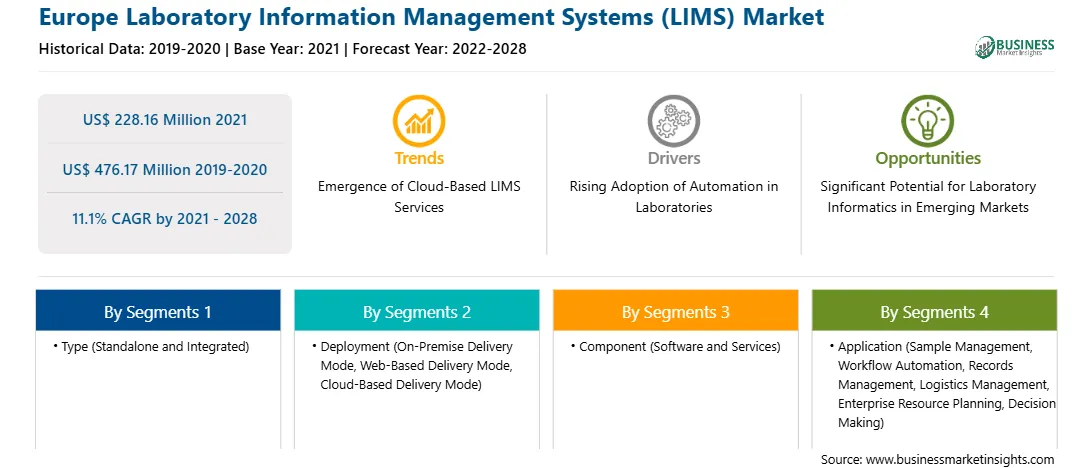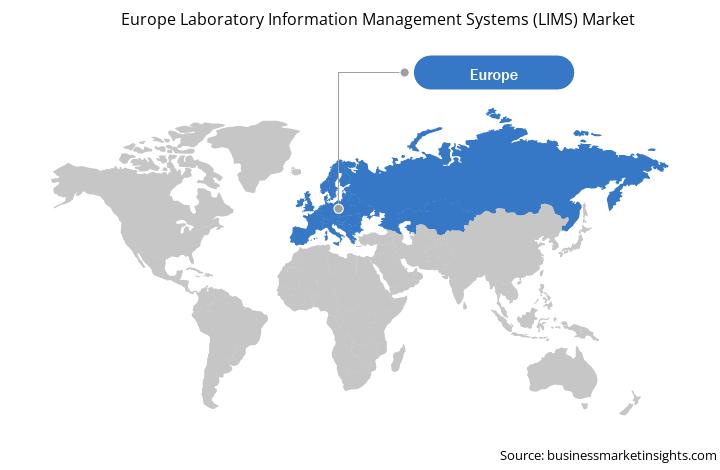Europe Laboratory Information Management Systems (LIMS) Market
No. of Pages: 148 | Report Code: TIPRE00027965 | Category: Technology, Media and Telecommunications
No. of Pages: 148 | Report Code: TIPRE00027965 | Category: Technology, Media and Telecommunications
Laboratory automation is emerging as an approach to minimize human involvement in laboratory processes. The automation of routine laboratory procedures with the help of dedicated workstations and system software helps increase laboratory efficiency and enables researchers to concentrate on important tasks along with avoiding human errors. Laboratories are increasingly adopting laboratory information management systems (LIMS) to maintain stringent regulatory compliance, uplift efficiency and productivity, and drive data security and integrity. According to a study published in the Journal of Lab Automation, the error incidences in fully automated, semi-automated, and manual operations are 1–5%, 1–10%, and 10–30%, respectively. The growing use of digital workstations, automated analyzers, and total laboratory automation (TLA) allows laboratory personnel to reassign activities and contribute a greater value to operations. Moreover, high volumes of data generated by laboratory systems is triggering the demand for effective data processing, analysis, and sharing methods, thereby highlighting the need of efficient and cost-effective solutions such as the LIMS. Laboratory management departments are facing many challenges with a rising population submitting larger number of samples to laboratories and a lack of personnel to process those samples. These challenges are compelling them to maintain their laboratory operations, as laboratories have to maintain control over the influx of samples as well as find the way to improve workflow to deliver patient results in a timely manner. Further, growing demand for data integration is another factor contributing to the laboratory information management systems market growth. With pharmaceutical and biotechnological industries spending huge amounts on research and development activities, the scientific communities are generating huge volumes of data. The appropriate processing and interpretation of the collected data requires data integration solutions. For instance, in 2000, Quest Diagnostics, a prominent independent testing laboratory, started providing their consumers with a direct access to test results through the TheDailyApple.com website owned and managed by Caresoft Inc. It offers direct-to-consumer test result, thereby ensuring confidentiality and anonymity of patients. Manual processes and paper records may allow unauthorized access to data, which increases the chances of data manipulation, and hence, managing data integrity is a big challenge faced by laboratories dependent on manual operations. Increasing adoption of electronic health record (EHR) systems in outpatient clinics and hospitals, to mitigate the risks associated with manual operations, would fuel the demand for LIMS. The systems also allow the use of laboratory data to offer safe and high-quality patient care. Thus, the growing focus on effective clinical workflow management, leading to the rise in automation if laboratory processes, is driving the laboratory information management systems market growth.
The European economy is severely affected due to the exponential growth of COVID-19 cases in the region. Spain, Italy, Germany, France, and the UK are among the most affected European countries. As number of patients in European healthcare setting has increased dramatically due to this outbreak, laboratories are at risk of diagnostic error. However, LIMS solutions help companies and organizations to run their laboratories remotely and from multiple locations. With the outbreak of the COVID-19 pandemic, most laboratories conducted their data-oriented processes from home using cloud-hosted, remote-based LIMSs. Several laboratories, CROs, research institutes, and pharma and biotech companies have worked uninterruptedly during the pandemic, thereby increasing productivity. Therefore, web-hosted solutions help achieve long operational life, decrease ownership cost, and offer excellent investment returns. Since the pandemic’s onset, prominent players in the laboratory information systems landscape are collaborating with public and private sector organizations to employ advanced technologies for implementing COVID-19 testing capabilities. For instance, LabWare Technologies has collaborated with the National Health Service to provide laboratory management software to healthcare settings across the United Kingdom.
With the new features and technologies, vendors can attract new customers and expand their footprints in emerging markets. This factor is likely to drive the Europe laboratory information management systems (LIMS) market. The Europe laboratory information management systems (LIMS) market is expected to grow at a good CAGR during the forecast period.
Strategic insights for the Europe Laboratory Information Management Systems (LIMS) provides data-driven analysis of the industry landscape, including current trends, key players, and regional nuances. These insights offer actionable recommendations, enabling readers to differentiate themselves from competitors by identifying untapped segments or developing unique value propositions. Leveraging data analytics, these insights help industry players anticipate the market shifts, whether investors, manufacturers, or other stakeholders. A future-oriented perspective is essential, helping stakeholders anticipate market shifts and position themselves for long-term success in this dynamic region. Ultimately, effective strategic insights empower readers to make informed decisions that drive profitability and achieve their business objectives within the market.

| Report Attribute | Details |
|---|---|
| Market size in 2021 | US$ 228.16 Million |
| Market Size by 2028 | US$ 476.17 Million |
| Global CAGR (2021 - 2028) | 11.1% |
| Historical Data | 2019-2020 |
| Forecast period | 2022-2028 |
| Segments Covered |
By Type
|
| Regions and Countries Covered | Europe
|
| Market leaders and key company profiles |
|
The geographic scope of the Europe Laboratory Information Management Systems (LIMS) refers to the specific areas in which a business operates and competes. Understanding local distinctions, such as diverse consumer preferences (e.g., demand for specific plug types or battery backup durations), varying economic conditions, and regulatory environments, is crucial for tailoring strategies to specific markets. Businesses can expand their reach by identifying underserved areas or adapting their offerings to meet local demands. A clear market focus allows for more effective resource allocation, targeted marketing campaigns, and better positioning against local competitors, ultimately driving growth in those targeted areas.

The Europe Laboratory Information Management Systems (LIMS) Market is valued at US$ 228.16 Million in 2021, it is projected to reach US$ 476.17 Million by 2028.
As per our report Europe Laboratory Information Management Systems (LIMS) Market, the market size is valued at US$ 228.16 Million in 2021, projecting it to reach US$ 476.17 Million by 2028. This translates to a CAGR of approximately 11.1% during the forecast period.
The Europe Laboratory Information Management Systems (LIMS) Market report typically cover these key segments-
The historic period, base year, and forecast period can vary slightly depending on the specific market research report. However, for the Europe Laboratory Information Management Systems (LIMS) Market report:
The Europe Laboratory Information Management Systems (LIMS) Market is populated by several key players, each contributing to its growth and innovation. Some of the major players include:
The Europe Laboratory Information Management Systems (LIMS) Market report is valuable for diverse stakeholders, including:
Essentially, anyone involved in or considering involvement in the Europe Laboratory Information Management Systems (LIMS) Market value chain can benefit from the information contained in a comprehensive market report.